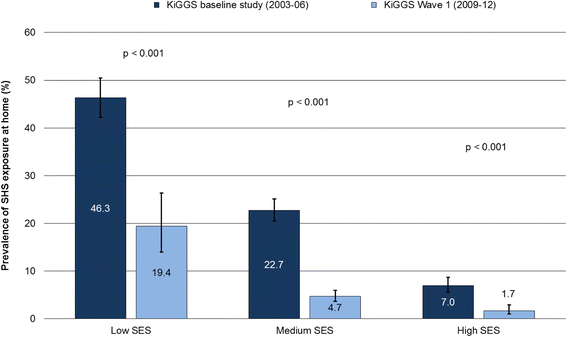Social disparities in parental smoking and young children's exposure to secondhand smoke at home: a time-trend analysis of repeated cross-sectional data from the German KiGGS study between 2003-2006 and 2009-2012
- PMID: 27277721
- PMCID: PMC4898452
- DOI: 10.1186/s12889-016-3175-x
Social disparities in parental smoking and young children's exposure to secondhand smoke at home: a time-trend analysis of repeated cross-sectional data from the German KiGGS study between 2003-2006 and 2009-2012
Abstract
Background: Children who are exposed to secondhand smoke (SHS) have an increased risk of a wide range of health problems and illnesses. Smoke-free legislation aims to improve indoor air quality and in this way protect the health of people who do not smoke. This paper examines trends in SHS exposure at home among children in Germany since the introduction of smoking bans in public places. Special focus is placed on the importance of the family of origin's socioeconomic status (SES) and on parental smoking behaviour.
Methods: The analyses are based on two waves of the "German Health Interview and Examination Survey for Children and Adolescents" (KiGGS)-one of which was conducted immediately before the introduction of central smoke-free legislation in the 2003-2006 period, the other approximately 6 years later from 2009 to 2012. A comparison is made between the answers given by the parents of children aged between 0 to 6 (KiGGS baseline study, n = 6680; KiGGS Wave 1, n = 4455). Domestic SHS exposure is covered in the parent interviews by asking whether anyone is allowed to smoke at home in the presence of their child. Parental smoking behaviour is determined separately for mothers and fathers. SES is determined on the basis of the parents' education, occupational status and income.
Results: The percentage of 0- to 6-year-old children exposed to SHS in the parental home fell from 23.9 to 6.6 % in the period from 2003-2006 to 2009-2012. At the same time, the percentage of children with at least one parent who smokes decreased from 49.8 to 41.8 %. While relative social inequalities in parental smoking behaviour have tended to increase over time, inequalities in domestic SHS exposure have persisted. Children whose parents smoke and children from low-SES families are still most likely to be exposed to tobacco smoke. In both study periods and after statistical adjustment for parental smoking behaviour, children with a low SES had a 6.6-fold higher risk for SHS exposure in the parental home than children from high-SES households.
Conclusions: The results of the KiGGS study show that the proportion of children in Germany who are exposed to SHS at home has declined significantly over the last few years. There is much to suggest that the smoke-free legislation that has been introduced in Germany has led to a heightened awareness of the health risks of SHS both in public and in the private sphere, as well as to a denormalization of smoking. Children whose parents smoke, and among them particularly children from socially disadvantaged families, should be recognised as key target groups when implementing future tobacco-control measures.
Keywords: Children; Environmental tobacco smoke (ETS); Germany; Health inequalities; KiGGS; Parental smoking; Secondhand smoke (SHS) exposure; Smoke-free legislation; Socioeconomic position; Tobacco control.
Figures




References
-
- USDHHS . The health consequences of involuntary exposure to tobacco smoke: a report of the Surgeon General. Atlanta: U.S. Department of Health and Human Services, Centers for Disease Control and Prevention, Coordinating Center for Health Promotion, National Center for Chronic Disease Prevention and Health Promotion, Office on Smoking and Health; 2006.
-
- Tobacco Advisory Group of the Royal College of Physicians . Report on passive smoking and children. London: RCP; 2010.
MeSH terms
Substances
LinkOut - more resources
Full Text Sources
Other Literature Sources
Medical

